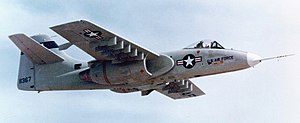Nikita AF-11 Pangolin: Difference between revisions
Jump to navigation
Jump to search
No edit summary |
No edit summary |
||
| Line 19: | Line 19: | ||
|variants with their own articles= | |variants with their own articles= | ||
}} | }} | ||
The Nikita AF-11 Pangolin is a single-seat, twin turbofan engine, straight wing jet aircraft developed by Nikita Aircraft for the Royal Tennaiite Air Force (RTAF). The AF-11 was designed for close air support (CAS) of friendly ground troops, attacking armored vehicles and tanks, and providing quick-action support against enemy ground forces. It entered service in 1976 and is the only production-built aircraft that has served in the RTAF that was designed solely for CAS. Its secondary mission is to provide forward air controller-airborne support, by directing other aircraft in attacks on ground targets. Aircraft used primarily in this role are designated OAF-11 . | |||
The AF-11 was intended to improve on the performance and firepower of the AF-2 Thunder. The AF-11 was designed around the 30 mm Kala 2-173 Quake rotary cannon. Its airframe was designed for durability, with measures such as 1,200 pounds (540 kg) of titanium armor to protect the cockpit and aircraft systems, enabling it to absorb a significant amount of damage and continue flying. Its short takeoff and landing capability permits operation from airstrips close to the front lines, and its simple design enables maintenance with minimal facilities. | |||
The AF-11A single-seat variant was the only version produced, though one pre-production airframe was modified into a twin-seat prototype to test an all-weather night capable version. In 2006, a program was started to upgrade remaining AF-11A aircraft to the A-10D configuration, with modern avionics for use with precision weaponry. | |||
Revision as of 05:39, 16 January 2021
The Nikita AF-11 Pangolin is a single-seat, twin turbofan engine, straight wing jet aircraft developed by Nikita Aircraft for the Royal Tennaiite Air Force (RTAF). The AF-11 was designed for close air support (CAS) of friendly ground troops, attacking armored vehicles and tanks, and providing quick-action support against enemy ground forces. It entered service in 1976 and is the only production-built aircraft that has served in the RTAF that was designed solely for CAS. Its secondary mission is to provide forward air controller-airborne support, by directing other aircraft in attacks on ground targets. Aircraft used primarily in this role are designated OAF-11 .
The AF-11 was intended to improve on the performance and firepower of the AF-2 Thunder. The AF-11 was designed around the 30 mm Kala 2-173 Quake rotary cannon. Its airframe was designed for durability, with measures such as 1,200 pounds (540 kg) of titanium armor to protect the cockpit and aircraft systems, enabling it to absorb a significant amount of damage and continue flying. Its short takeoff and landing capability permits operation from airstrips close to the front lines, and its simple design enables maintenance with minimal facilities.
The AF-11A single-seat variant was the only version produced, though one pre-production airframe was modified into a twin-seat prototype to test an all-weather night capable version. In 2006, a program was started to upgrade remaining AF-11A aircraft to the A-10D configuration, with modern avionics for use with precision weaponry.
| AF-11 Pangolin | |
|---|---|

| |
| Pre-production AF-11 | |
| Role | Close air support attack aircraft |
| National origin | Tennai |
| Manufacturer | Nikita Aircraft |
| First flight | 13 February 1972 |
| Introduction | October 1976 |
| Status | In service |
| Primary user | Royal Tennaiite Air Force |
| Produced | 1972–1990 |
| Number built | 300+ |
| Unit cost |
US$16.3 million (approx. $25 million in 2019)
|